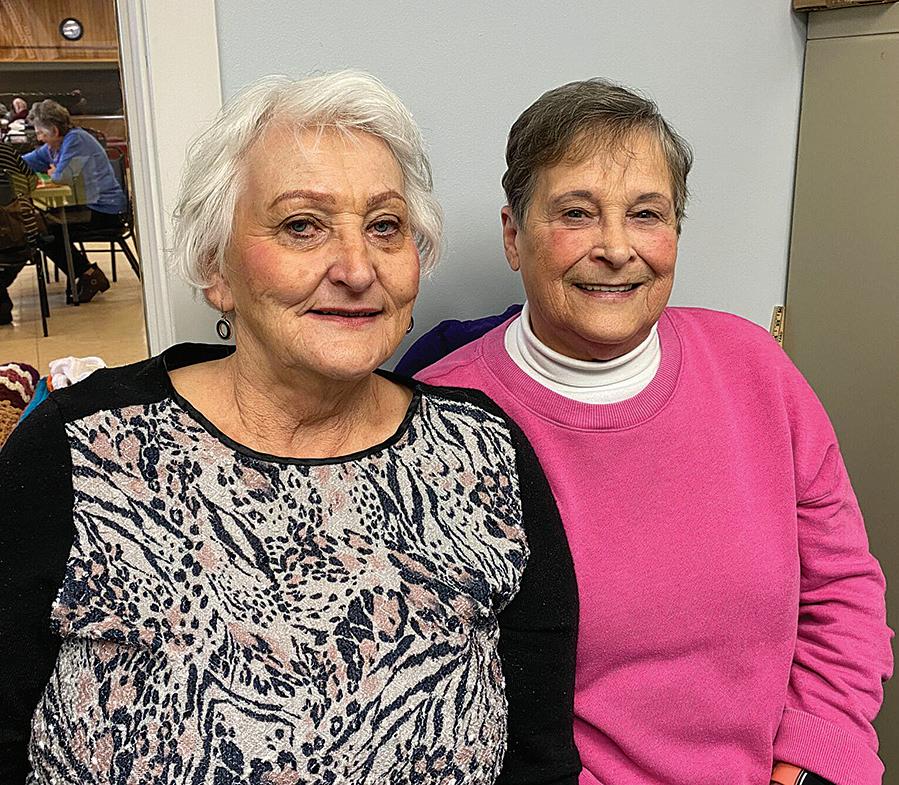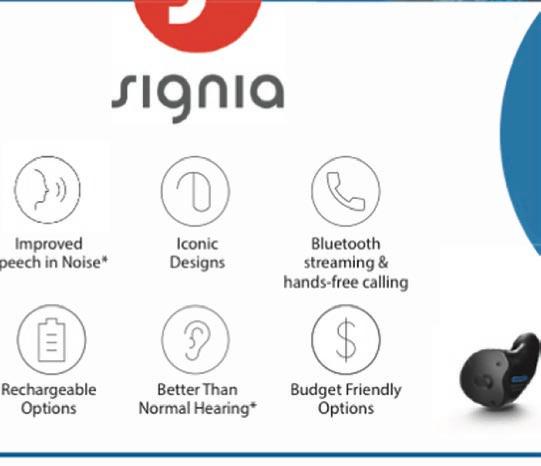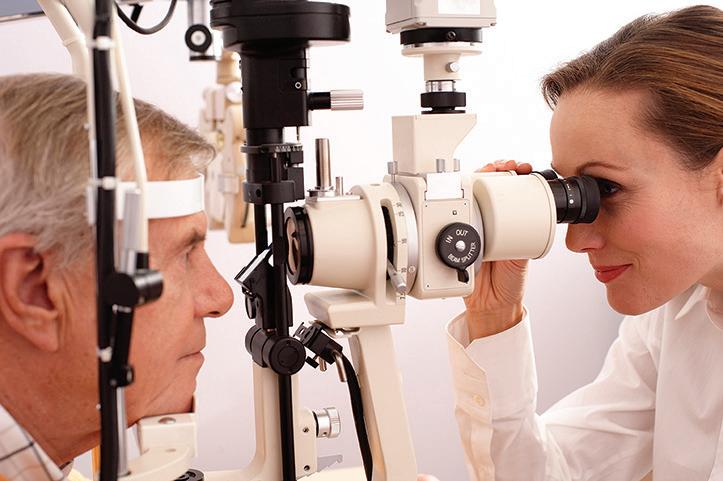Young at Heart

Seniors gather for a group photo at a Christmas party at Alpena Senior Citizens Center.
Story on page 2
SUPPLEMENT TO THE ALPENA NEWS • WEDNESDAY, FEBRUARY 12, 2025


Seniors gather for a group photo at a Christmas party at Alpena Senior Citizens Center.
Story on page 2
SUPPLEMENT TO THE ALPENA NEWS • WEDNESDAY, FEBRUARY 12, 2025
By DARBY HINKLEY News Lifestyles Editor
ALPENA — Staying active as a senior is healthy, fun, and vital for a good life. Just ask friends Bozena Lynch, 78, and Marilyn Ceglarek, 81. The pair attend exercise classes at Alpena Senior Citizens Center, as well as doing outdoor chores, walking, and exercising at home when the weather is not cooperative.
“I live by myself,” Lynch said. “I lost my husband over 10 years ago. I cut grass in the summertime, and I walk. I love to walk.”
She attends exercise classes at the senior center on Monday, Wednesday, and Friday, and volunteers at the center on Tuesday and Thursday.
“When we come to exercise, we usually come early,” Lynch said. “About half an hour, and we call it social hour.”
She said it’s important to take care of yourself, and
that includes physical activity.
“I think it’s very good for people to be active and exercise,” Lynch said. “I think this town has got so much to offer, but sometimes you have to look. Don’t be afraid to get out of the house. Go visit your friends, or somebody. I think a lot of people have got the problem of sitting home too much.”
She said getting out of the house and socializing, as well as exercising, is important to a balanced, healthy life.
“I stay busy, and I’ve got aches and pains,” Lynch said. “I’m not perfect, but I’m health-wise lucky.”
The ladies have been friends for about 10 years. They met at an exercise class at Curves.
“When Curves closed, we started coming here,” Ceglarek said of the senior center.
Right after Curves closed, Ceglarek started walking four miles a day on the treadmill at the Alpena

Community College Fitness Center. Then, after the pandemic, she started attending exercise classes at the senior center.
“Even on snow days, when I’m at home, I try to exercise at least a little bit,” Lynch said.
She added that she is fortunate enough to have a neighbor who clears the snow for her.
“I repay him with Polish cookies,” she said.
“Then I’ll come shovel your snow,” Ceglarek said with a laugh.
Ceglarek attends exercise as often as possible.
“I come, basically, three times a week,” she said. “And at home, I’ve got a bike. I do walking in the summer, around the neighborhood.”
Ceglarek added that she does a lot of chores, inside and out, around the house.
“I just keep up,” she said. “I don’t sit around … I’m busy all the time.”
She walks with her son when he visits.
“When my son comes, we park at Mich-e-ke-wis and we walk over to the boat harbor and back,” Ceglarek said.
She had open-heart surgery in 2004, but she didn’t let that slow her down.
“I probably was in my late 40s before I really started,” Ceglarek said of exercising. “I was active, but not doing all these exercises. I still lift weights at home and ride my bicycle. Stationary.”
Lynch has been exercising regularly since 1999.
“In the summertime, I love to walk and watch all the flowers that people have in the front,” Lynch said. “Because I love flowers.”
She enjoys walking on the city sidewalks near her home, and greeting others as they walk by.
“I think it’s nice because this town is safe, I think,” Lynch said. “Walking outside in the summertime, you’d be surprised how you meet people.”
Lynch and Ceglarek exercise because they enjoy it.
“I love to exercise, because I love to move,” Lynch said. “It’s not because we have to. We want to.”
Lynch keeps a positive attitude, as well.
“Every day is a good day,” she said.
She welcomes any seniors to come check out classes and programs at the senior center.
“If anybody wants to get together, just come and join the seniors,” Lynch said. “We have so much fun over here, and there are so many different programs here.”
The Alpena Senior Citizens Center is located at 501 River St., Alpena. Call the center at 989-3563585, or email info@alpenaseniors.com.

The rewards of parenting are bittersweet. Raising children successfully means they will one day leave home and embark on lives of their own. Once the proverbial chicks leave the nest, individuals may be left with a lot of empty home and a lot of time to fill.
According to the U.S. Census Bureau, there were 22.5 million empty nesters in the country in 2020, with most having become empty nesters between the ages of 40 and 60. Statistics Canada says roughly one-third of adults between the ages of 20 and 34 lived with their parents in 2023. Although some parents whose children have reached adulthood still provide financial assistance to their grown children due to high costs of living, many empty nesters in their fifties have greater financial resources and much more time to fill their days with activities unrelated to parenting. But how does one spend those hours when they had been filled with parenting-related obligations and activities for so long?
The following are five unique ways empty nesters can stay busy and socially engaged as they seek to avoid empty nest syndrome.
1. Take care of yourself. After all those years of putting children first, now is the time to make yourself the priority. Explore all of the ways to engage in self-care. Maybe you were thinking about signing up for a monthly massage package at a nearby wellness clinic but procrastinated because of the added expense? Or you may have wanted to splurge on a facial or new hair treatment? Now
is the time to make those appointments.
2. Prioritize hobbies. Identify rewarding hobbies that might have been pushed to the back burner for years. If you always wanted to learn a new language, why not immerse yourself in it and the associated culture by spending a month or more in a country where that language is spoken? Now can be a great time to pick up new hobbies as well. Aim for activities that are social in nature, like the ever-popular pickleball.
3. Travel far and wide. Travel is a popular pastime among empty nesters and retirees. When you no longer have to coordinate travel around school schedules and holidays, you can take advantage of great deals on off-peak travel and really see the country or even the world.
4. Indulge your social life. If parenting made it hard to attend certain social functions, now you’ll have the time to engage with friends more regularly. You can reach out to old friends and start a weekly walking group, join a book club, sign up for a fitness class together, or even do a monthly wine and dine meet-up at new restaurants in the area.
5. Adopt a pet. When children were still at home you likely lavished attention on them each day. You can redirect some of that affection to a pet who needs a good home. Visit a nearby animal shelter and pick out a pup or kitten looking for a good home.
Empty nesters have more free time to redirect to their own passion projects and interests.



Busy days tend to be productive days. But when especially busy days are strung together, adults can begin to feel a little overwhelmed and may wonder if there’s anything they can do to make hectic schedules more manageable.
Time management strategies can be an effective tool in busy adults’ arsenals. Efficient time management can free up more minutes or hours in the day, which can ultimately afford adults more time to exhale and thus make each day seem a little less overwhelming. Time management may require a little trial and error before adults find a formula that works for them, but the following are some tips to improve personal efficiency each day.
• Identify tasks that can be tackled at night. A hectic start to a morning can set a bad precedent for the rest of the day. With that in mind, adults can
identify tasks they can perform at night to ensure mornings are less hectic. Lay out clothes the night before to save the trouble of finding an outfit in the morning. Prepare the family’s lunches and even breakfasts the night before so mornings go more smoothly.
• Exercise in the morning. A recent study from the World Health Organization published in the Lancet Global Health Journal found that 31 percent of adults don’t get enough exercise. Lack of routine physical activity has been linked to a host of negative health outcomes, including an increased risk for conditions like heart disease, diabetes, cancer, and stroke. Adults who exercise at night may find that attempts to squeeze in early evening or nighttime workouts add to feelings of being overwhelmed brought on by busy schedules. Exercising in the morning can free







up time for other tasks in the evening, and doing so can even make it easier to manage daily stress, as the Mayo Clinic reports that exercise in any form releases endorphins and helps to relieve stress.


• Minimize distractions. Distractions are arguably more prevalent than ever, as many adults feel nary a minute goes by without a smartphone notification and/or message from friends, family and coworkers. Minimizing those distractions and resolving to tackle one task at a time can improve efficiency and reduce stress. Turn off smartphone notifications from apps that are not vital to work and family. During the workday, prioritize tasks each day and block off hours on your schedule so time can be devoted exclusively to the most
important jobs. If hours on a schedule are left open, coworkers may schedule meetings that can make it difficult to complete necessary tasks.
• Adjust as necessary. Flexibility is a must when making an effort to avoid feeling overwhelmed. Each day presents its own unique and fluid challenges, so remaining flexible can help busy adults overcome unforeseen obstacles. In addition, some time management strategies may not be effective for everyone nor useful every day, so it’s best to recognize the need to adjust from time to time.
Time management strategies can help busy adults efficiently manage each day and hopefully reduce instances when individuals feel overwhelmed.

Aging and change go hand in hand. Although some may bemoan the gray hairs that start to arrive or stiffness in the knees that seems to sneak up on a person in middle age, such concerns are not necessarily enough to lose sleep over. However, many people 50 or older are nervous about the potential for cognitive issues like dementia as they grow older.
The Alzheimer’s Association estimates that 6.7 million people have Alzheimer’s disease in the United States. The Alzheimer Society of Canada estimates that there were 733,040 people living with dementia in the country as of January 1, 2024. Alzheimer’s disease and other dementias can rob people of their memories, personalities and abilities to live satisfying, independent lives. While it may not be impossible to prevent all cognitive issues com-
pletely, there is reason to believe that reading could be an ally in cognitive care.
The American Academy of Neurology says that reading stimulates the brain and has been shown to slow down cognitive decline in old age. Reading also may help slow down memory loss.
The powers of reading were noticed more than 10 years ago when a 2013 study from researchers at Emory University measured readers’ MRI scans as they read books. They found the deeper readers went into a story, the more areas of their brains were activated. This activity remained elevated for several days after participants finished their books. The more a person reads, the stronger complex networks in the brain become.
Additional evidence that reading can help the brain was noted by re-
searchers at the Texas A&M School of Public Health. A 2024 study suggests that older people with mild cognitive impairment who engage in high levels of activities like reading, hobbies and word games have better memory, working memory, attention, and processing speed than those who do not take part in such endeavors. Furthermore, a
2021 study published in Neurology found that high levels of cognitive activity, like reading and writing letters, can delay the onset of Alzheimer’s disease by five years among those age 80 and over. Reading can keep brains functioning optimally and potentially delay age-related cognitive decline.

Physical changes are a normal byproduct of aging. Gray hairs and less elastic skin that contributes to wrinkles may be among the more notable physical signs of aging, but older individuals also may note their vision is not what it once was.
Diminished vision can be a byproduct of various conditions. Aging individuals who have noticed a loss of vision may be dealing with age-related macular degeneration, or AMD. Seniors concerned by AMD can learn about the condition so they’re wellpositioned to manage it if and when they need to.
The National Eye Institute notes that AMD is an eye disease that is the leading cause of vision loss for
older adults. In fact, Johns Hopkins Medicine notes age is the most common cause of severe loss of eyesight among people 50 and older. The NEI notes that aging causes damage to the macula, which is the part of the eye that controls sharp, straight-ahead vision. When a person has AMD, his or her central vision is blurred.
Because AMD blurs the central vision, people who develop the disease may struggle to recognize faces, read, drive, or engage in activities that require close-up work, including cooking or fixing things around the house.
Are all cases of AMD the same?
The NEI notes that AMD happens


very slowly in some people and faster in others. Some people may not recognize they have vision loss even when they already have early AMD. In addition, there are two types of AMD:
• Dry AMD: Dry AMD is the most common type of the disease and occurs as the macula gets thinner with age. Dry AMD progresses slowly over several years, and occurs in three stages: early, intermediate and late.
• Wet AMD: Wet AMD is a less common form of late AMD that the NEI notes typically causes faster vision loss. Wet AMD occurs when abnormal blood vessels grow in the back of the eye and damage the macula. Wet AMD is treatable.
AMD produces different symptoms depending on the stage of the dis-
Keith Wallace, William Pfeifer & Theodore Johnson experienced attorneys right here in Alpena
ease. Early dry AMD does not cause any symptoms, and the NEI notes some people with intermediate dry AMD may not experience symptoms. Those who do may notice symptoms such as mild blurriness in their central vision or difficulty seeing in low lighting. Late wet or dry AMD patients may notice that straight lines are beginning to look wavy or crooked and there may be a blurry area near the center of their vision. That blurriness can grow larger over time and people may begin to see blank spots. Colors also may seem less bright and people may have difficulty seeing in low lighting.
The NEI notes that adults over 55 are more likely to have AMD than any other group. People with a family history of AMD, Caucasians and smokers also have a higher risk of developing AMD. Quitting smoking, getting regular physical activity, maintaining healthy blood pressure and cholesterol levels, and eating a healthy diet that includes leafy greens and fish are some ways people can lower their AMD risk.
AMD is most common among individuals over 50. More information is available at nei.nih.gov.

The phrase “bigger is better” has endured for quite some time. Though it may be impossible to pinpoint precisely who coined the phrase, its lesson that larger things tend to be more valuable than smaller alternatives is applicable in numerous situations. But no adage is applicable to every situation, and in some instances people may find that bigger is not better.
Downsizing is an approach many individuals consider after turning 50. Parents who are empty nesters and others nearing retirement may wonder if the time is right to downsize from their current homes. Though that’s a strategy millions of people have adopted over time, the decision is not always so simple. Individuals over 50 who are trying to determine if downsizing is right for them can consider a host of factors before making a decision.
• Monthly housing expenses: Before downsizing their homes, individuals should determine just how much they’re currently spending on housing. Individuals who have fixed rate mortgages likely know the amount of their monthly mortgage payment, but what about maintenance? Home maintenance expenses fluctuate, but a careful examination of the previous 12 months’ expenditures can give homeowners an idea of just how much they’re spending to maintain their properties. The number may be eye-opening, as Thumbtack’s “Home Care Price Index” released in the third quarter of 2024 revealed that the average annual cost to maintain a single family home reached an all-time high of $10,433. If such expenses are preventing homeowners from building their retirement nest eggs, then it might be time to seek alternative
housing.
• Real estate prices: Real estate prices have skyrocketed in recent years, which can be both good and bad for current homeowners considering downsizing. Many people who downsize look to move from a singlefamily home into a condominium, where maintenance tasks are typically handled by a homeowners’ association (HOA). Such communities typically charge HOA fees, which can be minimal or considerable. In addition, the price of condominiums has risen in recent years, with the lender New American Funding reporting in early 2024 that the median sale price of a condo reached $341,000. So homeowners who want to downsize their homes may end up taking most of the profit from selling their current properties and reinvesting it in a costly condo. Some may deem that worth-
while, while others may find the cost savings of downsizing in the current market are negligible.
• Emotional attachment: Downsizing may be considered with cost savings in mind, but it’s important to consider your emotional attachment to your current home. Many homeowners over 50 raised their families in their current homes, and letting go of a property where so many memories were made can be difficult. Homeowners who are not prepared to move on from properties that are meaningful to them and their families can consider additional ways to downsize their financial obligations.
Downsizing is something many homeowners over 50 consider. Any decision regarding downsizing is best made after considering a range of variables.

To schedule a local heart and vascular appointment, call (989) 356-0141.